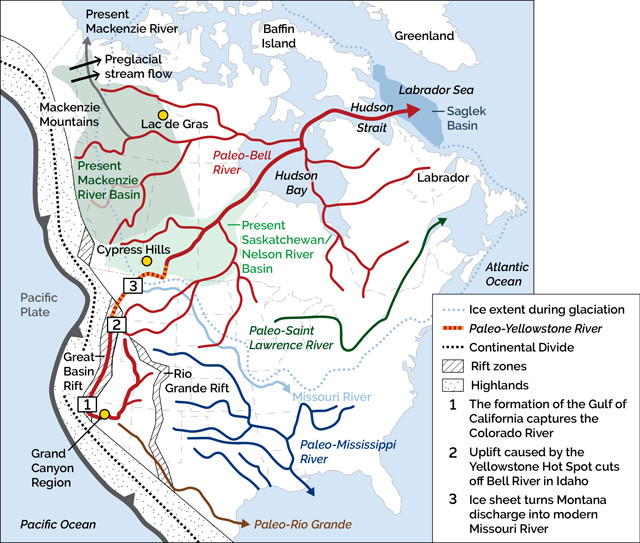Kingdom of Kwazulu (formerly Zululand or Zulu Kingdom) is a Southern African monarchy, alongside Lesotho and Eswatini, that emerged in 1816 under the leadership of the legendary warrior king Shaka Zulu. Under Shaka's leadership, the Zulu Kingdom expanded rapidly, conquering neighboring tribes and kingdoms, establishing itself as the dominant power in the region before Shaka was assassinated by his own brothers in 1828 – the first of many brotherly battles in Zulu history.
However, the Zulu Kingdom continued to be a major power in the region under the reigns of his successors, most notably King Cetshwayo, who became the ruler of the Zulu Kingdom in 1873 Under his leadership, the Zulu Kingdom enjoyed a period of relative peace and prosperity, with extensive social and economic development taking place. When Cetshwayo became king of the Zulus, according to custom he created a new capital for the nation, naming it "Ulundi" - "The High Place". But as the Zulu Kingdom courageously faced a war against the advancing British colonialists, Cetshwayo’s city of dreams became a bloodstained wasteland, his kingdom’s armies finally crushed at the Battle of Ulundi.
Following the defeat at Ulundi, the Zulu Kingdom was brought under British rule and King Cetshwayo exiled to Cape Town, forced to sign a humiliating treaty that reduced Zululand to a landlocked shred of its former self. However, facing vicious revolts by the vengeful Zulu, the British allowed Cetshwayo to return to the ruins of his homeland and rebuild his trampled capital – but as time went on and kings changed one after one, the ruthless colonialists continued to take cut after cut out of Zululand, till little remained but the king’s personal crown lands around the royal kraal of Ulundi, a speck lost in the South African veld.
Nearly a century later, Zululand found itself surrounded by the apartheid regime and bordering its insidious political creation – the Bantustan of KwaZulu. Bantustans were designed to be separate homelands for native ethnic groups in South Africa and KwaZulu was meant for the Zulu, most of whom lived under apartheid rule beyond Zululand’s royal borders. Naturally the apartheid government claimed that this policy was designed to promote self-determination for different ethnic groups, but in reality, it was merely a way to justify the forced removal of native people from their homes and the stripping of their South African citizenships.
However, despite their differences, the kingdom and the bantustan had one thing in common – for they were both led by noble descendants of the royal bloodline. Once more the Zulu people were torn by a conflict between brothers: King Goodwill Zwelithini and Chief Minister Mangosuthu Buthelezi – cousins descended from the great King Cetshwayo. Buthelezi was a charismatic leader who believed in using political means to achieve the Zulu people's goals, founding the Inkatha Freedom Party for the Zulu people, and becoming the sole Chief Minister of KwaZulu. Jealous as he was of Zululand’s sovereignty, Buthelezi nevertheless stridently refused to accept the full – but largely fraudulent –independence offered by the South African government, unlike the “independent” bantustans of Bophuthatswana and Transkei, seeing true freedom for his people.
Unlike his modernist cousin, King Zwelithini was a traditionalist who believed in the power of the monarchy to unite the Zulu people and protect their interests – a stance Buthelezi subverted by recognizing the king’s role in KwaZulu’s constitution but reducing him to a figurehead ordered to hold aloof from politics. To his allies he presented it as a victory of modernism over monarchism – to his enemies it was proof that Buthelezi plotted to install a more pliable king in Ulundi or claim the crown for himself, a rumor that enraged the royal family in Ulundi and drew the ire of monarchists.
But as the apartheid regime began to crumble, the power struggle between Buthelezi and Zwelithini grew ever more bitter. KwaZulu was torn between republican groups led by the Inkatha Freedom Party advocating for reunification with South Africa and monarchist groups demanding KwaZulu’s unification with the Zulu Kingdom. In the end, Buthelezi triumphed by securing an alliance with Nelson Mandela and the African National Congress. Eventually compromise was reached - while the Bantustan of KwaZulu would reunify with South Africa, the royal crown would be granted ownership over much of the former bantustan’s territories in the form of the Ingonyama Trust, for the benefit, welfare, and well-being of the Zulu nation. Led by the king, the trust would own 29.67% of the land in KwaZulu-Natal equivalent to 28,000 square kilometers. But Buthelezi had two conditions – the royal crown would not directly endorse monarchist movements in KwaZulu-Natal and the kingdom would remain known as Zululand.
Buthelezi had the final laugh – the offer was too good to refuse. In the end, he was the one ruling over KwaZulu, while his cousin was left to reign over Zululand.
Nevertheless, the two sides of Zulu leadership managed to cooperate for the good of the Zulu people for decades, as South Africa struggled to become the “Rainbow Nation” of Mandela’s dreams. However, in the wake of Eswatini’s renaming from Swaziland in 2018, the new ambitious young Zulu king struck down the “wicked imposition” and announced the renaming of the kingdom from Zululand to the Kingdom of Kwazulu in 2020. Political leadership of KwaZulu-Natal fiercely opposed the change, arguing that it was tantamount to a declaration of war and a territorial claim by the king onto all of KwaZulu-Natal. Despite attempts by the South African government and fellow monarchs of Lesotho and Eswatini to moderate the conflict, provincial leadership continues to threaten to blockade the Kingdom or to nationalize the Ingonyama Trust territories, much to the fury of monarchist groups in the province.
Despite the turmoil, the Zulu people continue to celebrate their traditions and culture, whether it be in modern wear on the streets of Durban or in their ancestors’ garb on the Reed Dance ceremony in Ulundi, admiring the conquests of Shaka, the fortitude of Cetshwayo, the good will of Zwelithini, and the tenacity of Buthelezi.



